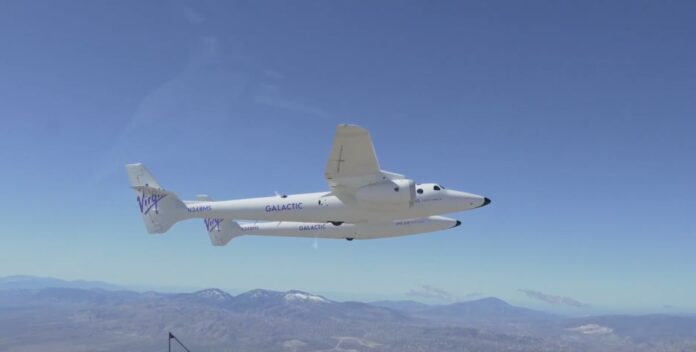Virgin Galactic’s carrier plane just took to the skies for the first time in nearly 16 months.
The aircraft, known as VMS Eve, conducted a test flight from California’s Mojave Air and Space Port on Wednesday (Feb. 15), Virgin Galactic announced in a brief Twitter update (opens in new tab). The flight lasted more than 2.5 hours and reached a maximum altitude of about 41,500 feet (12,650 meters), according to SpaceNews (opens in new tab), which cited flight tracking data.
It was Eve’s first liftoff since late October 2021 (opens in new tab), when the plane flew to Mojave from Spaceport America in New Mexico to receive a series of modifications and upgrades.
In photos: Virgin Galactic’s 1st fully crewed spaceflight with Richard Branson
VMS Eve is a key piece of Virgin Galactic’s space tourism hardware. During operational flights, the plane carries the company’s six-passenger VSS Unity spaceliner to an altitude of about 50,000 feet (15,000 m). The piloted Unity then drops free and fires up its rocket motor, powering its way to suborbital space.
The duo have conducted four such spaceflights to date, most recently in July 2021, when Unity carried four passengers — including Virgin Group founder Richard Branson — to and from the final frontier.
Shortly after that flight, Virgin Galactic announced it was going to upgrade Eve and Unity, taking both vehicles out of operation for a spell. This work included replacing Eve’s center pylon, the point between the plane’s twin fuselages where Unity attaches.
Wednesday’s flight helped test the new pylon, among other features, even though Eve flew solo, according to Kelly Latimer, Virgin Galactic’s senior flight test director.
“One thing we will do is take it out — without any spaceship attached to it — up to high altitude, cold-soak it (make sure everything operates in extremely cold temperature), then we actuate the hooks that would normally attach to the spaceship and collect data on how they performed,” Latimer said in a Q&A that the company posted on Wednesday (opens in new tab).
VSS Unity is back at Spaceport America, and Eve will likely join the spaceliner there soon, Latimer said.
“After we complete system checks during initial flight test, Eve will fly what we call a ferry flight to New Mexico,” she said in the Virgin Galactic Q&A. “The team is excited to see Eve and Unity reunited again, and we have some more testing to do with the mothership and spaceship combined — including more ground testing, glide and powered flight to complete the required validations of the vehicle’s modifications.”
When those checkouts are done, Virgin Galactic will presumably be ready to resume crewed spaceflights. The first of those, a research mission for the Italian Air Force, is on target to lift off sometime this spring, Virgin Galactic representatives have said.
Mike Wall is the author of “Out There (opens in new tab)” (Grand Central Publishing, 2018; illustrated by Karl Tate), a book about the search for alien life. Follow him on Twitter @michaeldwall (opens in new tab). Follow us on Twitter @Spacedotcom (opens in new tab) or Facebook (opens in new tab).

